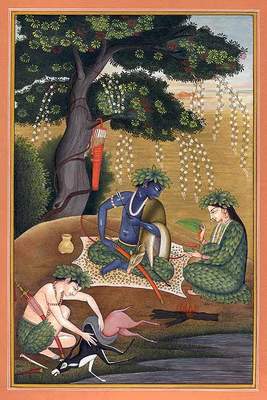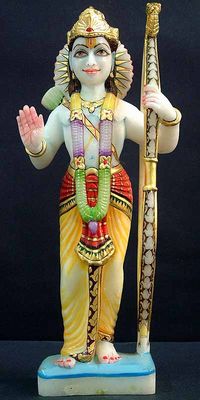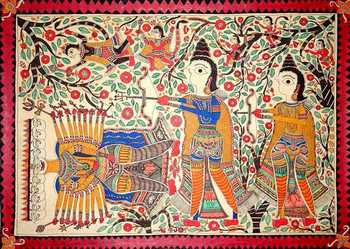Free Birth & Compatibility Charts
Cell Salts for Your Sign
Your Life Path Number
What Does Your Face Reveal?
What Your Day of Birth Says About You
|
Rama The Ideal Man: The Epic Adventure of a Hero
The air was rich with expectation. Though it was still
early morning, the entire city was up in joy. It was indeed a special
day. Today Rama, their beloved prince, was to be crowned. An embodiment
of virtue and righteousness, Rama was the eldest among four princes. But
fate had something else in store. Rama's father Dasharatha, himself a
generous and popular king, was forced under oath by one of his three wives
(Rama's stepmother), to banish Rama to the forest for fourteen years,
and to crown her own son instead.
There is no doubt that the throne rightfully belonged
to him. But what was Rama's reaction to these happenings? Not a slightest
sign of disappointment or sorrow crossed his face. Smiling, he said: "Surely
the king's promise must be fulfilled. My hair shall be twisted and I shall
wear the bark and go to the forest this very day." Dasharatha recognizing
the injustice of the situation requested Rama to disobey him, and seize
the throne by force. But Rama, insisting that there was no joy in getting
a kingship gained by the breaking of a promise or by the slaying of one's
own brothers, declined to do so.
Rama's adventures give ample opportunity to a willing
poet attempting to chronicle his exploits. All however point in the direction
which portrays him as the quintessential hero. This is achieved by presenting
him as spectacularly qualified to display his prowess across a variety
of situations requiring heroic succor. These characteristics casting Rama
in the complexion of the 'archetypal hero' can be classified as follows:
1) Facing the Unknown
2) Hero and the Goddess: Love
and Sublimation
3) Heroic Nobility
4) The Path of the Karmayogi
Facing the Unknown
The story of Rama is the story of the archetypal hero
who lies within the depths of our own psyche. His journey to the forest
is the unique voyage all of us must make. It is an adventure into the
mysterious and the unknown. The jungle or forest is an apt and well recognized
Jungian symbol for the unconscious self, and entering the dark forest
is a threshold symbol. It represents the soul entering the perils of the
unknown, a quest for the secrets of nature, and the spiritual world which
man must penetrate to find the meaning. According to Joseph Campbell:
The heroic life is living the individual adventure.
There is no security
in following the call to adventure.
Nothing is exciting
If you know
What the outcome is going to be.
To refuse the call
Means stagnation.
You enter the forest
At the darkest point,
Where there is no path.
Where there is a way or path,
It is someone else's path.
You are not on your own path.
If you follow someone else's
way,
You are not going to realize
your potential.
The goal of the hero trip
Down to the jewel point
Is to find those levels in the psyche
that open, open, open,
and finally open to the mystery
of your Self being
Buddha consciousness
Or the Christ.
That's the journey.

Thus Rama set off on this supreme adventure. He entered
the realm of uncertainty. Indeed it was a wise choice. Certainty implies
limitation, while uncertainty means stepping into the unknown, which holds
within it a million opportunities. The unknown is the field where all
possibilities might occur. It is ever fresh, ever new, and a fertile ground
for the germination of new ideas. Creative imagination here is not stifled
and limited by what is known, but stimulated by the boundless possibilities
open before it. This means that in every moment of life, there will be
excitement, adventure, and mystery. Thus without uncertainty and the unknown,
life is but a stale repetition of earlier, outworn memories. The path
of Rama hence is a headlong journey into life' s great adventures, a quest
into the unknown. This is the true path of the hero.
Hero and the Goddess: Love and Sublimation

Having
made themselves comfortable in the dense forest,
Rama and Sita continued to live as man and wife,
enjoying all the pleasures that attend to a married
and devoted couple.
Once after a particularly exhausting
session of sport among the perfumed jungles on
the banks of the full and flowing Ganges, Sita
settled down on Rama's lap. Just then a mischievous
crow came and nibbled at Sita with his beak. Disturbed,
Sita flung at him a pebble, trying to scare him
away. But the unscrupulous scoundrel would have
none of it and continued with his irritating activity.
Angered she got up, attempting to chase it away.
In the awkwardness of the situation, Sita's lower
garment slipped off, prompting a derisive laughter
from her husband. Ashamed and sullen, she hurried
back to rest her head on Rama's chest, her only
refuge, and shed tears.
Finally she entered the realm
of sleep, awakening only after some time had elapsed.
Now it was Rama's turn to rest in the lap of his
beloved. Suddenly the black and feathered creature
returned. This time his impudence crossed all
bounds of decency and he struck straight at the
space between Sita's breasts. His repeated actions
caused her to cry out in pain, waking Rama from
his peaceful slumber in the most joyful of beds.
Observing her plight he asked enraged, to name
the doomed creature who had marked the place between
her breasts. Looking around, his eyes rested on
the crow even then intently looking at Sita. Infuriated
Rama, in the spur of the moment, threw at the
mere crow the mightiest weapon in his arsenal
the 'brahamastra.' This weapon mapped the same
trajectory as the crow and followed him, however
hard he tried to evade the missile. Finally he
succumbed to the weapon and fell to the ground.
This sight re-ignited in Rama his benevolence
and mercy, qualities for which he was known far
and wide. Taking him into his refuge he forgave
the wretched creature.
The love of Rama and his lawfully wedded wife Sita
is the theme and substance of the Ramayana. True to the image of the mythic
hero, both the carnal and the sublime aspects are highlighted in this
epic, as in the majority of heroic lore across the world.
Celebrating another aspect of their affection is the
appreciation that theirs was a love in conformance with Dharma. Such a
love is but a manifestation of god. For those who interpret Ramayana in
a symbolic manner regard Sita as the individual soul and Rama as the Supreme
Being. God sees and pursues the human soul till He secures it. Thus did
Rama follow Sita's trail across astronomical distances to unite himself
with her. Verily is the Supreme Lord eager to save us.
Present in Ramayana is the twin theme of love opposed
to Dharma. This is the love Ravana felt for Sita and which prompted him
to abduct this chaste lady. He coveted the wife of another, which was
deemed a sin. Here it must be noted that labeling Ravana's intentions
towards Sita as love is paradoxical to say the least. Not once during
her captivity (twelve months) did Ravana make a physical advance towards
Sita. Not that he couldn't have done so. She was far away from any of
her sympathizers, and was but a prisoner in his kingdom on which he held
a authoritative and unquestionable sway. Ravana was obsessed with the
idea of generating in her heart an inkling of love for him. A fat chance
he had. With her commitment to her Lord as adamantine and devoted as always,
Sita, even during periods of extreme tribulations, never for a moment
let any other man enter her thoughts other than Rama.
There are also other interpretations of the love story
of Rama and Sita. In one such insight Sita is believed to be the female
counterpart of the Highest Being, an embodiment of compassion and grace.
Compassion is the Supreme Mother who rests enthroned in the heart of the
Lord. When she casts her merciful glance on us, we reach the feet of god.
Parvati's function in relation to Shiva and Lakshmi's in relation to Vishnu
are both identical, and are thought to point to the same truth namely
that God as father and God as mother are not distinct. Indeed if the Lord
were to be parted from his compassion, our plight would be like that of
Ravana, who separated Sita from her Lord Rama.
Heroic Nobility

Nobility is always a defining
quality of the mythic hero. His actions are severe
and punishing, or gentle as per the demand of
the situation. Hence even as he faced the mighty
Ravana in battle, Rama did not lose sight of the
highest ideals. Though valiant and brave, Ravana
couldn't match the prowess of Rama who sorely
wounded him in battle, breaking his golden crown
and chariot. Thus deprived of every weapon, he
stood helpless before Rama. Rama addressed him:
"You may go now, You have fought well today.
Go away and rest and come back tomorrow, refreshed
and with weapons."
This was the perfect opportunity for the hero to slay
Ravana. But it also would have been a conduct against the Dharma of a
true warrior. Harming an unarmed opponent was not considered an act of
courage by the truly brave.

In a second and decisive battle between these two titans
the evil one was slain.
All his kin having been killed earlier, it fell on
his surviving brother Vibhishana to perform his last rites. Vibhishana
had crossed over to Rama's side before the war began, recognizing correctly
that his brother was in the wrong. Vibhishana was reluctant to perform
Ravana's funeral rites recalling his evil deeds. It was at this moment
that Rama made one of the most profound statements to emanate from the
Ramayana. He said:
"Ravana fought like
a true warrior and fell fighting like a hero!
Death has washed his sins. Ravana has entered
heaven. It is for you now, his brother, to do
the rites. I, his former foe, even I can rightly
perform his obsequies. Your brother is my brother
too, is he not?"
Ravana had carried away Sita,
Rama's beloved wife, whom Rama valued more than
his own life. Now after having vanquished the
evil doer and having clinched victory, there remained
in Rama's heart no residual hard feelings. Ravana's
death had relieved him from the demerits of the
heinous crime he had committed by carrying away
the wife of another. But even then, his mission
accomplished, Rama had nothing but tenderness
in his heart for the fallen villain. This civilized
behavior is worthy of emulation by parties engaged
in modern warfare where not content with the annihilation
of the enemy a perverse pleasure is often relished
in the mutation and disfigurement of the foe.
Rama's enmity ended with Ravana's death. His enemy
was Ravana's evil deeds and not Ravana personally.
He bore no personal animosity to the dead warrior
but only followed the path of just and righteous
karma by inflicting upon the erring individual
the punishment due to him. When doing so, Rama
the humble man he was, didn't proclaim a divine
authority but only acknowledged that he was but
a tool in the hands of fate, an instrument of
destiny.
The Path of the Karmayogi
Ancient Indian philosophy stresses
the path of karma. An interesting story from the
Mundaka Upanishad illustrates the nuances of this
principle:
"Two birds sit on the
same branch of the same tree. One eats, and the
other looks on."
This simple story has a profound
underlying message, opening up and laying bare
an entire way of life, completely in harmony with
the rhythms of nature. The two birds which perch
on the tree are respectively the ego and the inner
self. These two dwell in the same body. While
the ego eats both the sweet and sour fruits of
our existence, the inner self which realizes its
true nature, watches in complete detachment.

Rama sought out his wife with
unmatched zeal and single-minded purpose. He who
loved her like life itself bore the agony of separation
for a year. Unable to reconcile himself to his
loss he wandered in the forest like a man possessed.
Accompanied only by his faithful brother Lakshmana,
he managed to win the confidence of Sugriva, the
monkey king at whose bidding the prodigious army
of simians was made available to him. He fought
a deadly battle where were lost thousands of lives,
all to regain his charming and faithful Sita.
Yet, finally having vanquished
Ravana, did he rush out to embrace Sita? Or make
haste to utter sweet words of love into her ears.
No. Rather this is what he said to her: "It
was not for mere attachment to you that I waged
this grim battle but only in the discharge of
the duty."
This supreme display of detached
attachment was worthy of Rama, idolized as the
ideal man. Never losing sight of his eventual
purpose he nevertheless was not overtly attached
to the result. On a practical level too this is
a sensible strategy, considering that any decision
we take during the course of our lives affects
not ourselves but also those in our immediate
environment. A healthy detachment is thus beneficial,
nay essential for those who wish to take a comprehensive
view of a situation. Too much obsession with the
result of a particular undertaking sows the seeds
of selfishness in our minds, blinding us to the
interest of those near to us. It is hence not
surprising that Rama was able to win the friendship
of the monkey king Sugriva . A sound strategist,
Rama secured Sugriva's friendship by helping him
regain his lost kingdom, which rightfully belonged
to him and had been unjustly appropriated. As
a commander he was known to inspire the confidence
of each and every individual who made up the army.
If Rama, understandably tense at the loss of Sita,
his most valuable possession, had focused solely
on the final retrieval of his wife could he have
applied the concentration required of a war strategist?
The answer is no. Burdened by the import and weight
of the result he wouldn't have been able to take
the risks necessary to win any war. This is true
as much as for the epic battle fought between
Rama and Ravana, as it is for achieving success
in any venture in life. Conclusion: Rama was a Man
Rama was a man. He was also a god. As each of us is.
This approach does not make him any less 'worshippable,' only more so.
Setting an example by action of valor tempered by sacrifice, he inspires
all of us 'ordinary' mortals to follow the path of a just and upright
existence, unswerving in our faith of the correctness of it. This is the
true inner journey of the hero, leading to the divine spark that blazes
inside each of us, waiting to be discovered.
References and Further Reading
- Chopra, Deepak. The
Seven Spiritual laws of Success: New Delhi,
2000.
- Cooper, J.C. An Illustrated
Encyclopedia of Traditional Symbols: London,
1999.
- Lash, John. The Hero
(Manhood and Power): London, 1980.
- Osbon, Diane K. A
Joseph Campbell Companion: New York, 1991.
- Rajagopalachari, C.
Ramayana (Translated into English): Mumbai,
2000.
- Satwalekar, Shripad
Damodar. The Ramayana (Translated into Hindi
with commentary, 11 vols.): Surat 1960.
- Tresidder, Jack. The
Hutchinson Dictionary of Symbols: Oxford, 1997.
We hope you have enjoyed reading the
article. Any comments or feedback that you may have will be greatly appreciated.
Please send your feedback to feedback@exoticindia.com.
This article by Nitin Kumar, Editor
Visit ExoticIndiaArt.com

 
|
Salt Remedy for Negativity and Psychic Protection
|